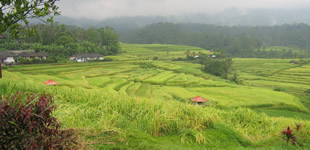 The SW monsoon rain that comes off of the Indian Ocean delivers 2 meters of rainfall to the south of Bali each year. Wet season storms quickly dump their load, followed by, blazing sunshine and blue skies. Bali’s rivers and man-made waterways carry nutrient rich water down mountain slopes in Amlapura, Klungkung, Gianyar, Tabanan and Badung. Rice farmers having sculpted terraced ricefields which are both pleasing to the eye and productive for the local people. These ricefields (sawah) produce vast quanities of rice, seen on ripening stalk and called padi. One hectare of sawah requires 1 million liters of fresh water per year.
The SW monsoon rain that comes off of the Indian Ocean delivers 2 meters of rainfall to the south of Bali each year. Wet season storms quickly dump their load, followed by, blazing sunshine and blue skies. Bali’s rivers and man-made waterways carry nutrient rich water down mountain slopes in Amlapura, Klungkung, Gianyar, Tabanan and Badung. Rice farmers having sculpted terraced ricefields which are both pleasing to the eye and productive for the local people. These ricefields (sawah) produce vast quanities of rice, seen on ripening stalk and called padi. One hectare of sawah requires 1 million liters of fresh water per year.
Balinese farmers have learned over centuries how to manage the flow of water, connecting sawah with underground pipes made from bamboo, which can be controlled. Coordinated rice planting means the entire population of a water course can plant and reap year round, multiple times. The success the Balinese rice farmers have had is directly related to the richness of the culture, allowing people to live healthy lives and have enough time for complex ceremonies and artisitic pursuits. Tabanan to the west of Denpasar is the most productive rice producing region in Bali and is home to Jatiluwih, a World Heritage site, which is a scenic section of small valleys of sawah.
Heading inland from the south coust, the elevation increases rapidly. Cooler weather and land which is unsuitable for terracing is used for cultivating bananas, cloves, cocoa, vanilla and coffee. The Dutch had a strong hand in some of these years ago. Venturing into the highlands you will also discover local fruits such as durian, the pungent ‘king of fruits’, rambutan, snake fruit (salak) and mangosteen, which Queen Victoria was particulary fond of. She should of tried sawo, the sweet, bread-flavoured, kiwi-like fruit.
The mid-elavations and highlands of Bali have developed a form of agroforestry, which is a semi-natural, man-made forest populated by a diverse selection of plants. With the rich volcanic soil that Bali has, fertilizers do not need to be used. For a westerner living in the highlands, this represents a great opportunity to try your own crops or take advantage of all the great local produce. The growing demand for salad items, not traditionally eaten by Indonesians, but driven by the hotel, resort, restaurant scene on the southern coast, means a whole host of great food is available.
When the highland areas of the mountain lakes are reached, grey clouds are present most of the time, local people wearing sweaters and hat. Rainfall in these areas is around 3 meters a year. In the highest elevations, which are the slopes of Gunung Agung and Gunung Batukaru, montane forests, complete with giant ferns and other cool climate flora are abundant.
Older visitors to Bali who may not appreciate the searing sunlight and stramy temperatures of the coastal areas, amy enjoy the peaceful beauty of central highlands. Areas such as Sanda, Bedugal, Munduk, Batukaru and Kintamani offer a different experience, one that can be rewarding with your own transport and a little time.